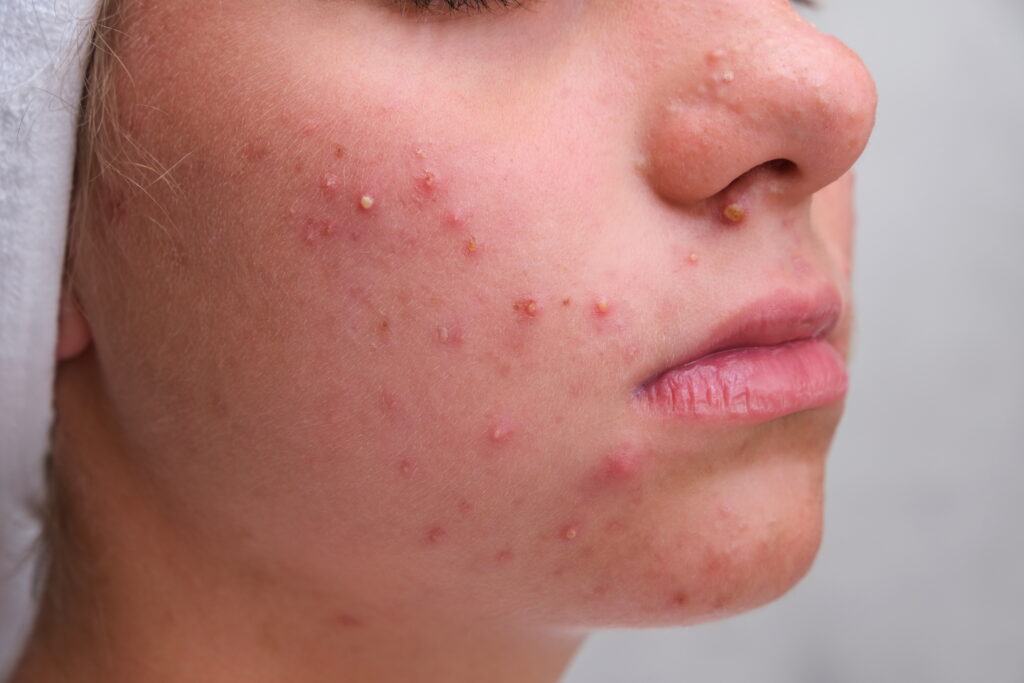Teenage Acne: Causes & Best Dermatologist Treatments
Teenage acne is one of the most common skin concerns globally, affecting nearly 80% of adolescents. During puberty, hormonal changes increase androgen levels, overstimulating the sebaceous glands, which produce excess oil. This excess sebum mixes with dead skin cells, clogging pores and creating an ideal environment for acne-causing bacteria. The result is whiteheads, blackheads, pimples, and sometimes painful cystic acne. If left untreated, teenage acne can lead to pigmentation, acne scars, and low self-esteem, making early intervention essential.
Causes of Teenage Acne
The primary cause of teenage acne is hormonal imbalance, which triggers overactive oil glands, leading to clogged pores and inflammation. Excess oil, combined with bacteria on the skin, results in red, inflamed pimples. Other contributing factors include:
- Diet & Lifestyle: High sugar intake, junk food, dairy, stress, irregular sleep patterns, and sedentary habits can worsen acne.
- Genetics: Teenagers with a family history of acne are more likely to develop it.
- Improper Skincare: Heavy creams, harsh scrubs, and frequent touching of the face can aggravate acne.
Understanding the underlying causes helps in selecting the most effective dermatologist-recommended treatments.
Types of Teenage Acne
Teenage acne can be categorized based on severity and appearance. Recognizing the type helps dermatologists choose the appropriate treatment:
- Whiteheads (Closed Comedones): Small, flesh-colored bumps caused by clogged pores. Mild in severity.
- Blackheads (Open Comedones): Dark-tipped pores due to oxidized oil and debris. Also considered mild acne.
- Papules: Small, red, inflamed bumps that indicate moderate acne.
- Pustules: Red bumps with pus at the tip, representing moderate acne.
- Nodules and Cysts: Deep, painful, and often large swellings under the skin. Severe acne that requires early dermatological intervention to prevent scarring.
Dermatologist-Recommended Treatments for Teenage Acne
- Topical Treatments
Topical treatments are often the first line of therapy for mild to moderate acne:
- Salicylic Acid: Helps unclog pores and exfoliate dead skin cells.
- Benzoyl Peroxide: Kills acne-causing bacteria and reduces inflammation.
- Adapalene (Retinoid): Prevents new acne formation and promotes skin cell turnover.
These medications should be used under professional guidance to avoid dryness or irritation.
- Oral Medications
Moderate to severe acne may require oral treatments:
- Antibiotics: Reduce bacterial infection and inflammation.
- Hormonal Therapy (for teenage girls): Balances hormones to control breakouts.
- Isotretinoin: Reserved for severe cystic acne under strict medical supervision.
- Advanced Dermatology Procedures
For faster results and prevention of scarring:
- Chemical Peels: Remove dead skin cells and reduce pigmentation.
- Laser Therapy: Targets bacteria and controls oil production.
- Comedone Extraction: Safely removes blackheads and whiteheads.
- Microneedling (for scars): Stimulates collagen to heal acne scars.
Skincare and Lifestyle Recommendations
Dermatologists emphasize combining medical treatments with proper skincare and lifestyle modifications:
- Daily Skincare: Cleanse twice daily with a gentle face wash, use a non-comedogenic moisturizer, and apply sunscreen daily.
- Diet Tips: Drink plenty of water, eat antioxidant-rich fruits, leafy greens, and omega-3-rich foods; avoid sugary and oily foods.
- Lifestyle: Ensure 7–8 hours of sleep, manage stress through yoga or exercise, and avoid touching or picking at pimples.
FAQs About Teenage Acne
Q1. Can acne go away on its own?
Mild acne may improve after puberty, but moderate to severe acne often requires dermatologist care to prevent scars and pigmentation.
Q2. Are home remedies like toothpaste or lemon effective?
No. These can irritate the skin and worsen acne.
Q3. Is oily skin the only reason for acne in teens?
No. Hormones, genetics, stress, diet, and improper skincare all play a role.
Q4. When should I see a dermatologist?
If acne is persistent, painful, causing scars, or affecting confidence, professional guidance is necessary.
Q5. How long does it take to see results?
Topical treatments may show results in 4–6 weeks, while oral medications or procedures may take 2–3 months depending on acne severity.
Conclusion
Teenage acne is a treatable condition, and early intervention by a dermatologist can prevent long-term complications like scarring and pigmentation. A combination of professional treatments, gentle skincare, healthy lifestyle choices, and proper diet ensures faster healing and clearer skin. Personalized care based on acne severity and skin type is the most reliable way to achieve acne-free, glowing skin. Taking action early not only improves skin health but also boosts confidence during these crucial teenage years.
Call to Action: If your teenager is struggling with persistent acne, consult a dermatologist today for a customized treatment plan that delivers safe and lasting results.

